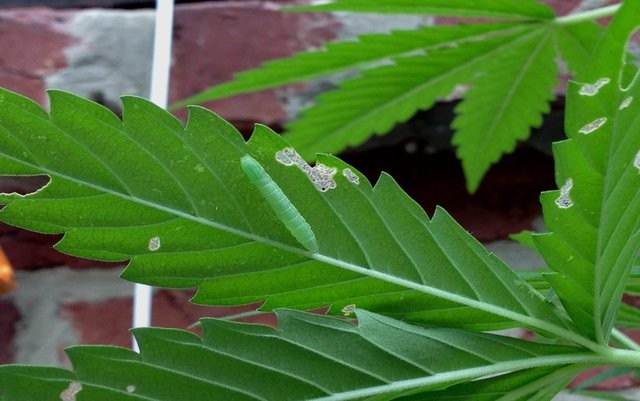
Spring is just around the corner, and if you grow outdoors you are probably thinking about starting your seeds or propagating clones very soon. Here in California, young plants are seen as a banquet by the ravenous larvae and caterpillars of several moths and butterflies.
Sometimes referred to as “Bud Worms” by cultivators of sun grown weed, the small green wormy or caterpillar-like Loopers are the larvae of Cabbage moths. (http://www.ipm.ucanr.edu/PMG/r108301011.html)
The adult Moth is an off-white to pale yellow with a tan to black eye spot on each wing. In my garden I always find the larvae infesting broccoli florets, ruining them the same way they destroy Cannabis colas. I’ve become quite adept at hand snatching the adult moths at rest or even in flight during my daily inspections as they flutter about or rest upon my Cape Gooseberry (Physalis peruviana); but you might want to consider wielding my other weapon. I use a butterfly collectors net to capture, ID, and kill these pests before they can lay eggs, interrupting the life cycle and preventing future larval infestations. Sadly, this trick does not work for me against an earlier season nemesis, the Leaf Roller.
There are several very small dark moths whose larvae are collectively known as leaf rollers. (http://www.ipm.ucanr.edu/PMG/PESTNOTES/pn7473.html) The most dangerous of these pests for Cannabis growers is the Light Brown Apple Moth. As the name implies, their favorite food are the tender young leaves at the growing tips of Apple trees. Here in California, damaging infestations of these larvae are now found on a wide range of crops. In my garden I am constantly on the lookout for rolled up or young webbed together leaves indicating the cottony housing which serves as a nursery for these wriggly hungry villains which upon maturation lower themselves to the ground like tiny wormy ninjas on a single, nearly invisible thread of silk to pupate in leaf litter. I’ve found them infesting Tomato, Pineapple Guava, Rocoto Pepper, Loquat, Pear, Lemon, Apricot, White Sapote and Tropical Guava.
Leaf rollers have several natural predators including birds and Lacewings; that plus daily hand removal of larval nurseries can keep infestations manageable. Bt (Bacillus thuringiensis ) is a bacterial insecticide which works well against Loopers. The leaves get sprayed, the loopers eat the leaves, become sickened, stop feeding, and die. Similarly, Spinosad will kill Leafrollers, but should be used carefully as it is also toxic to some beneficials. Neem and other herbal oils are not very effective against Leafrollers or Loopers. Be aware that Spinosad is banned from use on Cannabis in Colorado!
Disclaimer: Any advice and opinions offered about the cultivation of cannabis by Bruce N. Goren are his own and do not represent the University of California or the Master Gardener Program.





